- 1Departamento de Física e Astronomia/CF-UM-UP-CFP, Faculdade de Ciências, Universidade Do Porto, Porto, Portugal
- 2Department of Mathematics and Statistics, University of Massachusetts Amherst, Amherst, MA, United States
- 3Departamento de Física and Centro de Física Teórica e Computacional, Faculdade de Ciências, Universidade de Lisboa, Lisboa, Portugal
- 4Theoretical Division and Center for Nonlinear Studies, Los Alamos National Laboratory, Los Alamos, NM, United States
In the present work we propose a nonlinear anti-
1 Introduction
Dissipative systems, whose linear Hamiltonians obey parity-time
Nonlinear dimers (two-site-systems) [11–16] and quadrimers [17–19] are among the simplest systems allowing one to observe the above mentioned features. At this point in time, many of the relevant observations have been summarized in comprehensive reviews [20, 21] and books [22].
As is known from the above settings, specific symmetries of the underlying linear system impose constraints on the existence as well as on the types of nonlinear modes sustained by the system of interest. The literature mentioned above was mainly concerned with parity
While a systematic effort has been made to explore anti-
Our presentation is structured as follows. In Section 2, we briefly present and explain the relevant mathematical model. In Section 3, we analyze the existence of its nonlinear solutions. In Section 4, we again briefly discuss the spectral linearization around such waveforms. In Section 5, we present our numerical stability and dynamical results. Finally, in Section 6 we summarize our findings and present our conclusions as well as some directions for future study.
2 The Model
Bearing in mind optical applications to a two-waveguide geometry [24], atomic ones for a pair of two collective spin-wave excitations [25], or a pair of RLC circuits per the experiment of [26], we chose, arguably, the simplest model of an anti-
where C, δ and γ are real parameters describing non-conservative coupling between the waveguides (or circuits), difference of the propagation constants (it will be assumed without loss of generality that δ > 0), and gain (if γ > 0) or loss (if γ < 0) in the waveguides (or circuits), respectively. We notice, that while one of the parameters, say δ, in H0 can be scaled out, we keep all of them since they correspond to different physical processes, and thus facilitate interpretation of the results. The non-conservative nonlinearity in Eq. 1 is given by the diagonal matrix
with g = g1 − ig2 and g2 > 0 describes the nonlinear absorption (g1,2 and
We notice that the introduced system is characterized by the active (non-Hermitian) coupling which was previously addressed in a number of publications without [24–26, 30] and with conservative and non-conservative nonlinear contributions [33]. It is relevant to mention in passing that some of these works, including experimental ones such as [25] indicate how nonlinearity can be incorporated in the relevant considerations even though they do not study it in detail. Within the model (1), nonlinearity stems from self- and cross-phase modulation, characterized by the strengths g1 and
At the linear level, the eigenvalue problem for H0
is readily solved
where
describes the deviation from the EP δ = |C| of the linear Hamiltonian.
3 Nonlinear Case Steady State Solutions
Turning to the nonlinear problem we start with steady state solutions of Eq. 1 and employing the ansatz
where b is a real spectral parameter and ψ10 and ψ20 are real, we obtain the system
3.1 Equal Amplitude Solutions
Let us search for solutions with ψ10 = ±ψ20. Since Eq. 1 is invariant under the transformation ψ ↦ −ψ, we simplify the analysis by restricting our attention to the case ψ10 ≥ 0. Now the system (8)–(9) is reduced to two decoupled equations
that are readily solved, giving two steady state solutions
We also observe that the solution ψ10 = −ψ20 is obtained from Eq. 11 by the −π/2 phase shift.
Thus in total there are two (nontrivial) symmetric solutions, and they exist (i.e., have real propagation constant b) only for |C| > δ (recall that ψ10 is real). Whether just one of them exists or both of them is controlled by the relative size of γ and Λ. That is, assuming that g2 > 0, the solution with the (−) sign in Eq. 11 necessitates that Λ < γ in order to be real.
Interestingly, at the EP of the linear Hamiltonian, Λ = 0 or C2 = δ2, the two solutions in Eq. 11 coalesce at
Thus the EP of the linear problem is also a point of a SN bifurcation, leading to the emergence of the two symmetric nonlinear modes. This is a bifurcation reminiscent of the
3.2 Unequal Amplitude Solutions
We now search for solutions with unequal intensities which can be presented in the form
Observing that
Substituting Eq. 14 in Eqs 8, 9, multiplying the first of the obtained equations by cos(ξ/2) and the second one by sin(ξ/2), we get
Adding the two equations, simplifying, and equating real and imaginary parts we obtain the equations:
If instead we now subtract the two equations, again after simplification, and equating real and imaginary parts we obtain this time:
Using the last result in Eq. 16, and dividing by sin ξ we obtain
Using Eq. 18 also in Eq. 15 after simplifying we obtain:
Finally, using this value for b on the left hand side (LHS) of Eq. 17 (as well as Eq. 18), canceling terms, and multiplying through by 2g2/sin(ξ) we obtain:
So, by solving (19) and (21) we compute ξ and ϕ, which can then be replaced in Eq. 20 to obtain b. Together with Eq. 18 this gives the full solution for the asymmetric waveforms (i.e., specifying (A, b, ξ, ϕ)).
We can formally solve Eq. 19 to obtain:
Then, inserting this result into Eq. 21, and rearranging we obtain:
where we defined
We recognize from the two signs in the above algebraic equations (resulting from, e.g., Eq. 22) that two asymmetric solution families can be obtained from the above analysis. We now proceed to set up and subsequently explore the stability of these four (two symmetric and two asymmetric) families of solutions.
4 Stability Matrix
The solutions found above need to be analyzed for their stability, in order to assess their potential dynamical robustness. This is achieved by studying the eigenvalues of the stability matrix, given by
For the anti-
where:
and
Using the ansatz
we obtain the eigenvalue problem as follows
Thus the eigenvalues of
5 Numerical Results
We look for solutions of the asymmetric form by performing a Newton method search of the algebraic Eq. 23, followed by continuation in the parameter C of any solution thus found. For the symmetric solutions, we did the same, although we could simply use our explicit analytical expressions within the stability matrix (in order to identify their spectral stability properties).
Below we present some representative results for the parameter values γ = 1.0, δ = 0.1, g1 = 0.3, g2 = 0.4 and
For the symmetric case, Figures 1, 2 show the results for the “positive” branch (hereafter termed “upper”). Represented are the amplitudes of the two nodes (|A|2 and |B|2), the phase difference between them (ϕ) (left panel), and the complex plane representation of the eigenvalues for two values of the scanned parameter, C (right panel). Then, in the second figure we show the dependence on C of the real and imaginary parts of the eigenvalues. One can observe that the amplitude grows with C, while the phase difference (right axis) varies from π/2 to a little above zero. Superposed to the numerical results are those of the analytic expressions found above, and we can see that the two are essentially identical, as is of course expected. The right panel of Figure 1 shows that the eigenvalues are purely real and indeed, as shown in Figure 2, they remain real throughout.
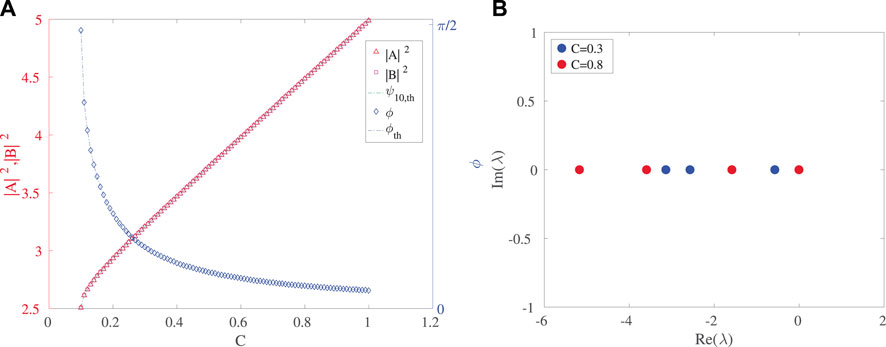
FIGURE 1. (A) Amplitude and phase of steady state symmetric solutions from the upper symmetric branch. (B) Spectral plane (Re(λ),Im(λ)) representation of the eigenvalues λ for C = 0.3 and C = 0.8. Other parameter values are γ = 1.0, δ = 0.1, g1 = 0.3, g2 = 0.4 and
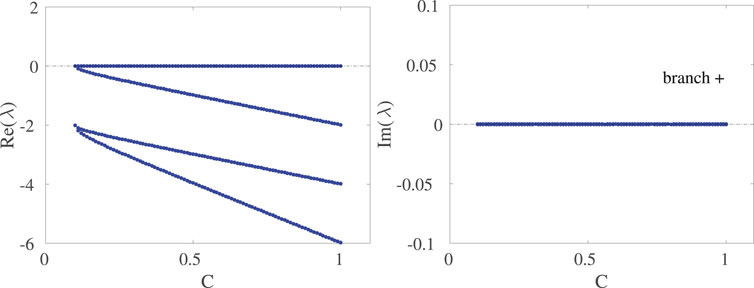
FIGURE 2. Dependence of the real and imaginary parts of the eigenvalues of steady state symmetric solutions from the upper (+) branch. The other parameter values remain as in the caption of Figure 1.
Figure 2 shows the real and imaginary parts of the eigenvalues as a function of C. Given that the largest value of the real part is zero, this upper branch is spectrally stable. That is, all the relevant eigendirections are associated with decay, aside from a neutral one (associated with an overall phase freedom). Recall that this is a non-conservative system, hence the relevant eigenvalues have to be in the left-half of the spectral plane (or on the imaginary axis thereof) for stability, as is the case for this branch. Indeed, we will see below that this is the only spectrally stable branch of this nonlinear anti-
In Figures 3, 4 we illustrate the corresponding results for the “negative sign” solution in Eq. 11, i.e., the hereafter termed lower branch. This time the amplitude decreases with increasing C, and the phase difference increases from just over π/2 to π. The continuation was started a little above C = δ; for C = δ we would expect both solutions to have ϕ = π/2. It is relevant to also note that the branches of Figures 1–3 coincide at the critical point of C = δ at which the relevant SN bifurcation arises with the upper branch corresponding to the node, while the lower one to the saddle. In accordance with this picture the spectra show again a purely real set of eigenvalues and in Figure 4 with one of them being positive and hence corroborating the instability of the saddle (−) symmetric configuration of the lower branch.
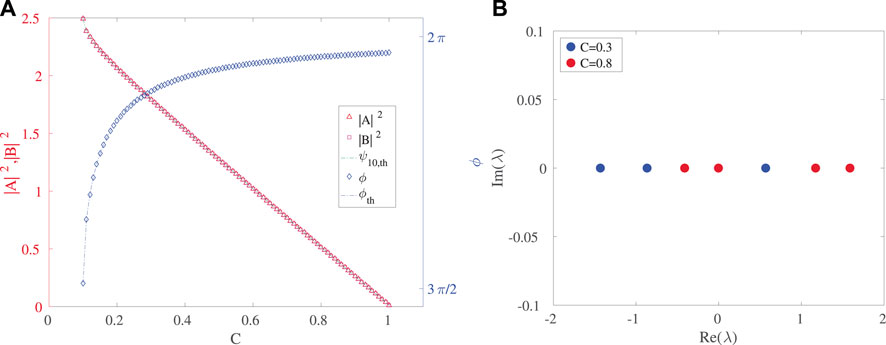
FIGURE 3. (A) Amplitude and phase of steady state symmetric solutions from the lower branch. (B) Spectral plane representation of eigenvalues for C = 0.3 and C = 0.8. The other parameter values are the same as in Figure 1.
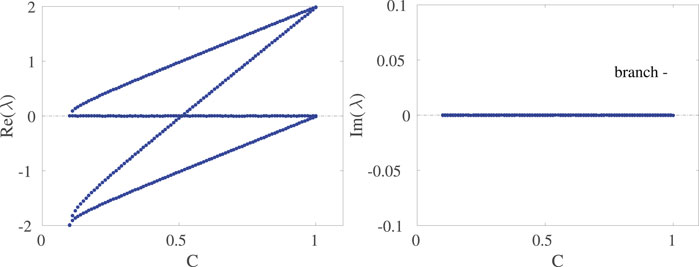
FIGURE 4. Linear spectra of steady state symmetric solutions from the lower branch. Importantly, in addition to the instability starting at the saddle-node bifurcation which gives rise to its existence, the solution inherits an additional instability at a bifurcation point of C = 0.51. The rest of the parameters are the same as in the previous Figures.
This is confirmed systematically also in Figure 4, where the relevant unstable eigenvalue is seen to grow from 0 beyond the bifurcation point. Interestingly, an additional unstable eigendirection arises at some intermediate value of C as well, rendering the relevant branch more unstable. We will return to the latter more elaborate bifurcation shortly. Nevertheless, for the interval of values of C considered, the former instability is always stronger (i.e., has a higher growth rate) than the latter one.
Now we turn to the results obtained for the two branches of asymmetric solutions. Here, the bifurcation picture is far more elaborate. The bifurcation diagram as a function of the parameter C is shown in Figure 5. Let us note that in this diagram the symmetric (node upper and saddle lower) branches are also shown and their SN bifurcations are shown via the green (solid) curves, while the asymmetric branches are shown with blue (dashed) lines. The main feature of the latter is that there is a 3-way collision between the 2 asymmetric branches and the lower symmetric one, close to
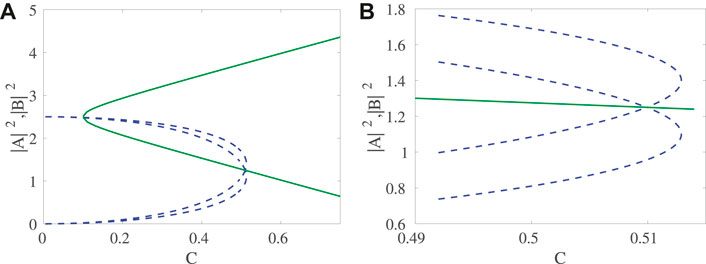
FIGURE 5. Bifurcation diagram as a function of (control) parameter C. (A) amplitudes |A|2, |B|2; (B) zoom in for the region where bifurcations occur. We do not show here the results for ϕ and ξ, although the same bifurcation features can be observed therein. The solid (green) lines pertain to the symmetric branches of solutions, while the dashed (blue) ones to the asymmetric branches.
Indeed, this picture is corroborated by the relevant eigenvalue plots. Figure 6 illustrates some prototypical examples of the spectral plane of the upper and lower asymmetric solutions. Both of them bear a complex eigenvalue pair (i.e., are associated with an oscillatory instability featuring both growth and oscillation, as we will also see below). However, in the case of the upper branch this instability is persistent up to C ≈ 0.430, while in the lower branch, it splits into two real eigenvalues earlier (parametrically), i.e., for C ≈ 0.287. Notice, accordingly, the difference for the red points of C = 0.4 in the right panel of Figure 6.
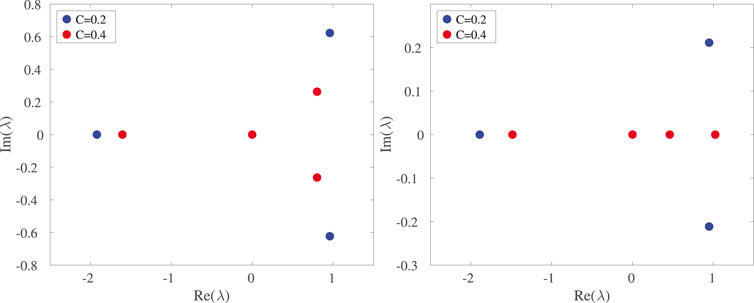
FIGURE 6. (A,B) Spectral plane representation of eigenvalues for C = 0.2 and C = 0.4 for the upper (left panel) and lower (right panel) asymmetric branches. The rest of the parameters are the same as in the previous figures.
The conversion of these complex pairs into real ones is also manifest explicitly in the top panels of the detailed Figure 7, which constitutes a central set of our numerical findings. Indeed, the top right panel shows how the complex pairs collide at the above critical points, thereafter splitting into two real eigenvalues for the respective branches, as shown in the top left panel of Figure 7. The left panel, admittedly, becomes rather complicated as we approach the critical points
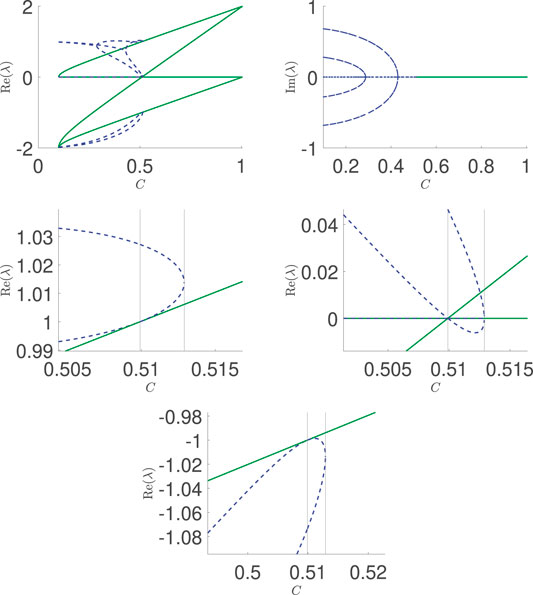
FIGURE 7. Eigenvalues of the asymmetric (and lower symmetric) branches as a function of (control) parameter C. Top left: real part; top right: imaginary part. The second and third row show details of the individual eigenvalues in the vicinity of the bifurcation points
5.1 Dynamics
Guided by the stability results we evolved initial conditions of both branches and both types of solutions for C values that should illustrate some of the principal features of the stability diagrams picture. In the case of the symmetric, upper branch we verified that initiating the dynamics along this branch yields a perfectly stable dynamical evolution, even upon perturbation of the branch (results not shown for brevity). On the other hand, the initial conditions belonging to the lower symmetric branch evolve towards the upper branch, as may be expected, given that for both C = 0.3 and C = 0.7 it has an eigenvalue with a positive real part and the only stable solution of the system is the upper symmetric one. This is shown in the top panels of Figure 8.
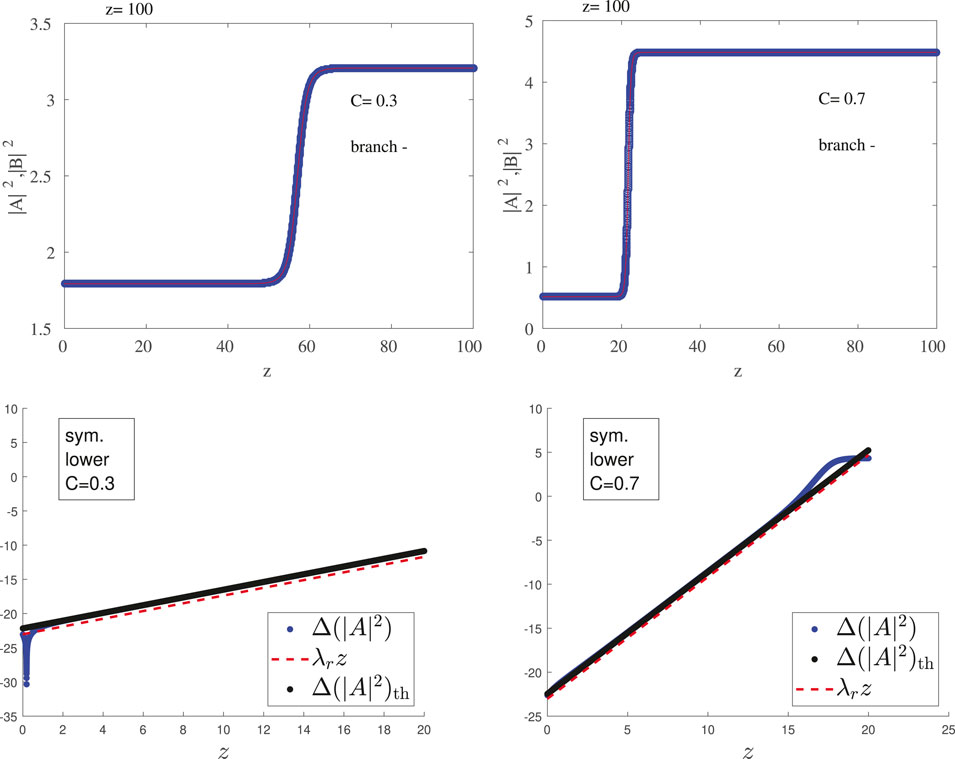
FIGURE 8. Evolution of symmetric steady state solutions from the lower branch in linear (top) and semilog (bottom) scale. The left panels are for C = 0.30 and right ones for C = 0.70. Other parameter values as in previous figures. It is clear (from the top panels) that the evolution tends to the stable symmetric (upper branch) structures. In the bottom panels, the difference of the amplitude from the steady state amplitude is shown, numerically (blue dots), and semi-analytically via the prediction of the linear stability analysis (black dots with subscript th). The growth of the exponential instability (linear in the semilog plot) based on the dominant eigenvalue is shown by the red dashed line. See also the discussion in the text.
To illustrate the relevant instability more clearly (and its connection with the spectral picture that we have previously obtained), we perturb the initial condition (steady state) with the eigenvector corresponding to the eigenvalue with the largest real part, in order to accelerate the decay and to check if the evolution corresponds indeed to the growth at a rate associated with the real part of the eigenvalue, λr,max (the maximal positive real eigenvalue). We present these results for the lower branch, both for C = 0.30 and for C = 0.70 in the lower panel of Figure 8. We plot the semilog of the variation in power relative to the steady state (subscript ss) solution,
Now let us look at the dynamics of the asymmetric solutions, both for the upper and lower branch, illustrated in Figures 9, 10, respectively. As predicted by linear stability, in both cases it is perceivable that the initial state evolves towards a symmetric state, and from the final amplitude it is the upper symmetric state, i.e., the only linearly stable configuration available in the system. This is shown in the linear scale plots of the top panels. On the other hand, we also present the semilog plots of the evolution of the departure from initial steady state. In this case we also represent the theoretical curve for the prediction for the evolution of the perturbation along the eigenvector with largest real part; this curve is denoted
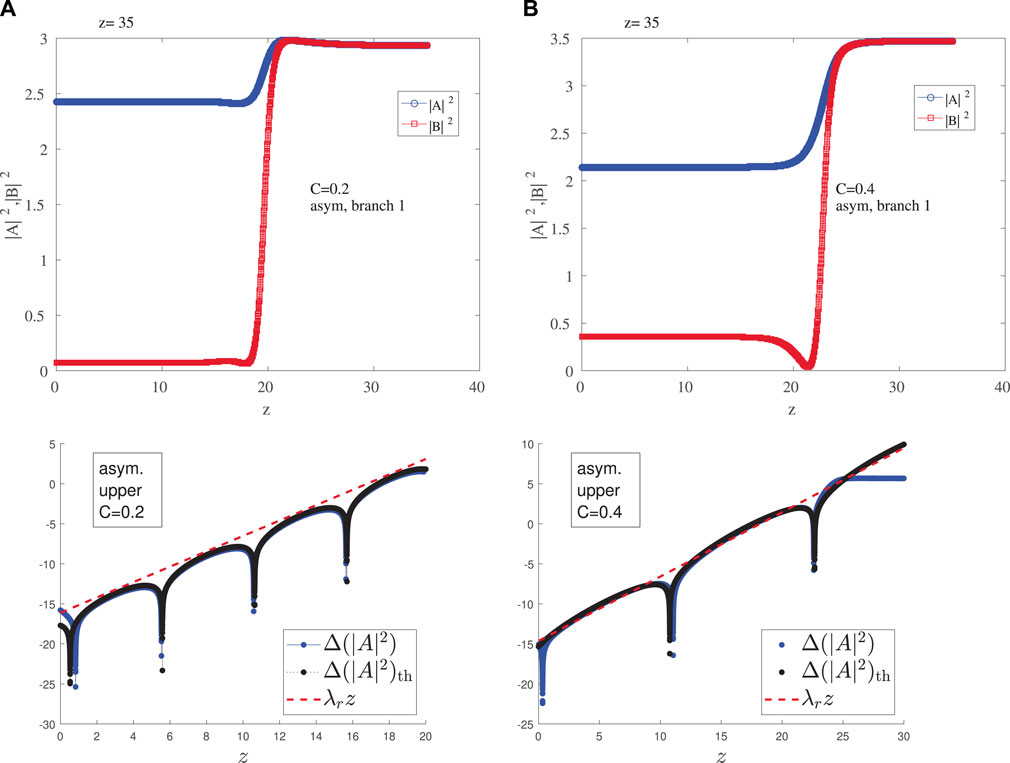
FIGURE 9. Evolution of steady state solutions from the asymmetric upper branch (A) C = 0.2 (B) C = 0.4. The amplitudes of the top panel evolve towards the symmetric values of the upper symmetric (stable) branch in the top panels. The bottom panels show the growth process in semilog scale corroborating not only the real part involving the growth (dashed red line), but also the imaginary part associated with the oscillation (cf. the theoretical curve in black vs. the numerical results in blue).
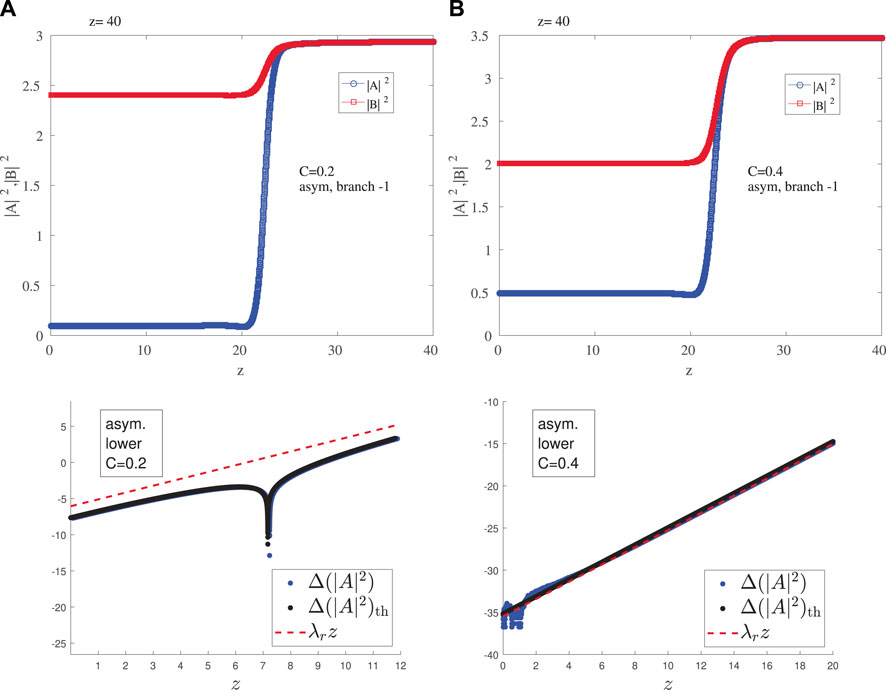
FIGURE 10. Evolution of steady state solutions from the asymmetric lower branch (A) C = 0.2 (B) C = 0.4. See text for other parameter values. The figure is similar to Figure 9, however for this branch the case of C = 0.2 has a complex pair, while that of C = 0.4 possesses only real eigenvalues; cf. Figure 6.
6 Conclusions and Future Work
In the present work, we have explored a nonlinear variant of the anti-
Naturally, these results pave the way for numerous further studies of anti-
Given that the bifurcation picture for the anti-
Data Availability Statement
The raw data supporting the conclusion of this article will be made available by the authors, without undue reservation.
Author Contributions
AR: Data curation, Investigation, Software, Validation, Visualization, Writing—original draft; RR: Data curation, Investigation, Software, Validation, Visualization, Writing—original draft; VK: Conceptualization, Methodology, Investigation, Writing—review and editing; AS: Conceptualization, Methodology, Investigation, Writing—review and editing. PK: Conceptualization, Methodology, Investigation, Validation, Supervision, Writing—original draft.
Funding
AR acknowledges financial support from FCT-Portugal through Grant No. UIDB/04650/2020. This material is based upon work supported by the US National Science Foundation under Grants No. PHY-2110030 and DMS-1809074 (PK). VK acknowledges financial support from the Portuguese Foundation for Science and Technology (FCT) under Contract no. UIDB/00618/2020. The work of AS at Los Alamos National Laboratory was carried out under the auspices of the U.S. DOE and NNSA under Contract No. DEAC52-06NA25396 and supported by U.S. DOE.
Conflict of Interest
The authors declare that the research was conducted in the absence of any commercial or financial relationships that could be construed as a potential conflict of interest.
Publisher’s Note
All claims expressed in this article are solely those of the authors and do not necessarily represent those of their affiliated organizations, or those of the publisher, the editors and the reviewers. Any product that may be evaluated in this article, or claim that may be made by its manufacturer, is not guaranteed or endorsed by the publisher.
References
1. Bender CM, Boettcher S. Real Spectra in Non-hermitian Hamiltonians Having PT Symmetry. Phys Rev Lett (1998) 80:5243–6. doi:10.1103/physrevlett.80.5243
2. Bender CM, Brody DC, Jones HF. Complex Extension of Quantum Mechanics. Phys Rev Lett (2002) 89:270401. doi:10.1103/physrevlett.89.270401
3. Rüter CE, Makris KG, El-Ganainy R, Christodoulides DN, Segev M, Kip D. Observation of Parity-Time Symmetry in Optics. Nat Phys (2010) 6:192–5. doi:10.1038/nphys1515
4. Peng B, Özdemir ŞK, Lei F, Monifi F, Gianfreda M, Long GL, et al. Parity-Time-Symmetric Whispering-Gallery Microcavities. Nat Phys (2014) 10:394–8. doi:10.1038/nphys2927
5. Peng B, Özdemir ŞK, Rotter S, Yilmaz H, Liertzer M, Monifi F, et al. Loss-Induced Suppression and Revival of Lasing. Science (2014) 346:328–32. doi:10.1126/science.1258004
6. Wimmer M, Regensburger A, Miri M-A, Bersch C, Christodoulides DN, Peschel U. Observation of Optical Solitons in
7. Schindler J, Li A, Zheng MC, Ellis FM, Kottos T. Experimental Study of Active LRC Circuits with PT Symmetries. Phys Rev A (2011) 84:040101. doi:10.1103/physreva.84.040101
8. Schindler J, Lin Z, Lee JM, Ramezani H, Ellis FM, Kottos T.
9. Bender N, Factor S, Bodyfelt JD, Ramezani H, Christodoulides DN, Ellis FM, et al. Observation of Asymmetric Transport in Structures with Active Nonlinearities. Phys Rev Lett (2013) 110:234101. doi:10.1103/physrevlett.110.234101
10. Bender CM, Berntson BK, Parker D, Samuel E. Observation of PT Phase Transition in a Simple Mechanical System. Am J Phys (2013) 81:173–9. doi:10.1119/1.4789549
11. Ramezani H, Kottos T, El-Ganainy R, Christodoulides DN. Unidirectional Nonlinear
12. Li K, Kevrekidis PG.
13. Rodrigues AS, Li K, Achilleos V, Kevrekidis PG, Frantzeskakis DJ, Bender CM.
14. Sukhorukov AA, Xu Z, Kivshar YS. Nonlinear Suppression of Time Reversals in PT-Symmetric Optical Couplers. Phys Rev A (2010) 82:043818. doi:10.1103/physreva.82.043818
15. Xu H, Kevrekidis PG, Saxena A. Generalized Dimers and Their Stokes-Variable Dynamics. J Phys A: Math Theor (2015) 48:055101. doi:10.1088/1751-8113/48/5/055101
16. Barashenkov IV, Pelinovsky DE, Dubard P. Dimer with Gain and Loss: Integrability and
17. Li K, Kevrekidis PG, Malomed BA, Günther U. Nonlinear
18. Zezyulin DA, Konotop VV. Nonlinear Modes in Finite-Dimensional PT-Symmetric Systems. Phys Rev Lett (2012) 108:213906. doi:10.1103/physrevlett.108.213906
19. Gupta SK, Deka JP, Sarma AK. Nonlinear Parity-Time Symmetric Closed-Form Optical Quadrimer Waveguides: Attractor Perspective. Eur Phys J D (2015) 69:199. doi:10.1140/epjd/e2015-60034-7
20. Suchkov SV, Sukhorukov AA, Huang J, Dmitriev SV, Lee C, Kivshar YS. Nonlinear Switching and Solitons in PT‐Symmetric Photonic Systems. Laser Photon Rev (2016) 10:177–213. doi:10.1002/lpor.201500227
21. Konotop VV, Yang J, Zezyulin DA. Nonlinear Waves in
22. Christodoulides D, Yang J. Parity-Time Symmetry and its Applications. Singapore: Springer Nature (2018).
23. Ge L, Türeci HE. Antisymmetric
24. Yang F, Liu Y-C, You L. Anti
25. Peng P, Cao W, Shen C, Qu W, Wen J, Jiang L, et al. Anti-Parity-Time Symmetry with Flying Atoms. Nat Phys (2016) 12:1139–45. doi:10.1038/nphys3842
26. Choi Y, Hahn C, Yoon JW, Song SH. Observation of an Anti-PT-Symmetric Exceptional point and Energy-Difference Conserving Dynamics in Electrical Circuit Resonators. Nat Commun (2018) 9:2182. doi:10.1038/s41467-018-04690-y
27. Cen J, Saxena A. Anti
28. Konotop VV, Zezyulin DA. Odd-Time Reversal PT Symmetry Induced by an Anti-PT-Symmetric Medium. Phys Rev Lett (2018) 120:123902. doi:10.1103/physrevlett.120.123902
29. Hang C, Zezyulin DA, Huang G, Konotop VV. Nonlinear Topological Edge States in a Non-Hermitian Array of Optical Waveguides Embedded in an Atomic Gas. Phys Rev A (2021) 103:L040202. doi:10.1103/physreva.103.l040202
30. Li Q, Zhang C-J, Cheng Z-D, Liu W-Z, Wang J-F, Yan F-F, et al. Experimental Simulation of Anti-Parity-Time Symmetric Lorentz Dynamics. Optica (2019) 6:67. doi:10.1364/optica.6.000067
31. Ge L, Wang W. In: PG Kevrekidis, J Cuevas-Maraver, and A Saxena, editors. Emerging Frontiers in Nonlinear Science. Cham: Springer International Publishing (2020).
33. Alexeeva NV, Barashenkov IV, Rayanov K, Flach S. Actively Coupled Optical Waveguides. Phys Rev A (2014) 89:013848. doi:10.1103/physreva.89.013848
34. Kevrekidis PG, Pelinovsky DE, Tyugin DY. Nonlinear Dynamics in PT-Symmetric Lattices. J Phys A: Math Theor (2013) 46:365201. doi:10.1088/1751-8113/46/36/365201
Keywords: anti-parity-time symmetry, nonlinearity, dimer, stability, symmetry breaking
Citation: Rodrigues AS, Ross RM, Konotop VV, Saxena A and Kevrekidis PG (2022) Nonlinear Anti-(Parity-Time) Symmetric Dimer. Front. Phys. 10:865910. doi: 10.3389/fphy.2022.865910
Received: 30 January 2022; Accepted: 16 March 2022;
Published: 26 April 2022.
Edited by:
Prasanta Panigrahi, Indian Institute of Science Education and Research Kolkata, IndiaReviewed by:
Bhabani Prasad, Banaras Hindu University, IndiaMaximo Aguero, Universidad Autónoma del Estado de México, Mexico
Copyright © 2022 Rodrigues, Ross, Konotop, Saxena and Kevrekidis. This is an open-access article distributed under the terms of the Creative Commons Attribution License (CC BY). The use, distribution or reproduction in other forums is permitted, provided the original author(s) and the copyright owner(s) are credited and that the original publication in this journal is cited, in accordance with accepted academic practice. No use, distribution or reproduction is permitted which does not comply with these terms.
*Correspondence: A. S. Rodrigues, YXNyb2RyaWdAZmMudXAucHQ=
 A. S. Rodrigues
A. S. Rodrigues R. M. Ross
R. M. Ross V. V. Konotop
V. V. Konotop A. Saxena4
A. Saxena4 P. G. Kevrekidis
P. G. Kevrekidis